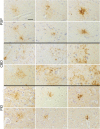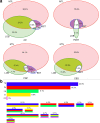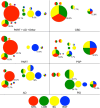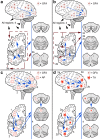Sequential stages and distribution patterns of aging-related tau astrogliopathy (ARTAG) in the human brain
- PMID: 29891013
- PMCID: PMC5996526
- DOI: 10.1186/s40478-018-0552-y
Sequential stages and distribution patterns of aging-related tau astrogliopathy (ARTAG) in the human brain
Abstract
Aging-related tau astrogliopathy (ARTAG) describes tau pathology in astrocytes in different locations and anatomical regions. In the present study we addressed the question of whether sequential distribution patterns can be recognized for ARTAG or astroglial tau pathologies in both primary FTLD-tauopathies and non-FTLD-tauopathy cases. By evaluating 687 postmortem brains with diverse disorders we identified ARTAG in 455. We evaluated frequencies and hierarchical clustering of anatomical involvement and used conditional probability and logistic regression to model the sequential distribution of ARTAG and astroglial tau pathologies across different brain regions. For subpial and white matter ARTAG we recognize three and two patterns, respectively, each with three stages initiated or ending in the amygdala. Subependymal ARTAG does not show a clear sequential pattern. For grey matter (GM) ARTAG we recognize four stages including a striatal pathway of spreading towards the cortex and/or amygdala, and the brainstem, and an amygdala pathway, which precedes the involvement of the striatum and/or cortex and proceeds towards the brainstem. GM ARTAG and astrocytic plaque pathology in corticobasal degeneration follows a predominantly frontal-parietal cortical to temporal-occipital cortical, to subcortical, to brainstem pathway (four stages). GM ARTAG and tufted astrocyte pathology in progressive supranuclear palsy shows a striatum to frontal-parietal cortical to temporal to occipital, to amygdala, and to brainstem sequence (four stages). In Pick's disease cases with astroglial tau pathology an overlapping pattern with PSP can be appreciated. We conclude that tau-astrogliopathy type-specific sequential patterns cannot be simplified as neuron-based staging systems. The proposed cytopathological and hierarchical stages provide a conceptual approach to identify the initial steps of the pathogenesis of tau pathologies in ARTAG and primary FTLD-tauopathies.
Keywords: ARTAG; Aging-related tau astrogliopathy; Astrocytic plaque; Brain barrier; Hierarchical involvement; Ramified astrocyte; Spreading; Tau; Tauopathy; Tufted astrocyte.
Conflict of interest statement
Ethics approval and consent to participate
Informed consent was obtained from next of kin in accordance with institutional review board guidelines of the University of Pennsylvania.
Competing interests
The authors declare that they have no competing interests.
Publisher’s Note
Springer Nature remains neutral with regard to jurisdictional claims in published maps and institutional affiliations.
Figures










Similar articles
-
Evaluating the Patterns of Aging-Related Tau Astrogliopathy Unravels Novel Insights Into Brain Aging and Neurodegenerative Diseases.J Neuropathol Exp Neurol. 2017 Apr 1;76(4):270-288. doi: 10.1093/jnen/nlx007. J Neuropathol Exp Neurol. 2017. PMID: 28340083 Free PMC article.
-
Aging-related tau astrogliopathy (ARTAG): harmonized evaluation strategy.Acta Neuropathol. 2016 Jan;131(1):87-102. doi: 10.1007/s00401-015-1509-x. Epub 2015 Dec 10. Acta Neuropathol. 2016. PMID: 26659578 Free PMC article. Review.
-
Astrocytic Tau Deposition Is Frequent in Typical and Atypical Alzheimer Disease Presentations.J Neuropathol Exp Neurol. 2019 Dec 1;78(12):1112-1123. doi: 10.1093/jnen/nlz094. J Neuropathol Exp Neurol. 2019. PMID: 31626288 Free PMC article.
-
Grey matter ageing-related tau astrogliopathy: associations with brain pathologies and cognitive decline.Brain. 2024 Oct 3;147(10):3501-3512. doi: 10.1093/brain/awae250. Brain. 2024. PMID: 39045644 Free PMC article.
-
Space-occupying brain lesions, trauma-related tau astrogliopathy, and ARTAG: a report of two cases and a literature review.Acta Neuropathol Commun. 2021 Mar 23;9(1):49. doi: 10.1186/s40478-021-01152-3. Acta Neuropathol Commun. 2021. PMID: 33757579 Free PMC article. Review.
Cited by
-
Chronic Traumatic Encephalopathy and Neuropathological Comorbidities.Semin Neurol. 2020 Aug;40(4):384-393. doi: 10.1055/s-0040-1713628. Epub 2020 Jun 30. Semin Neurol. 2020. PMID: 32629520 Free PMC article. Review.
-
Spectrum of tau pathologies in Huntington's disease.Lab Invest. 2019 Jul;99(7):1068-1077. doi: 10.1038/s41374-018-0166-9. Epub 2018 Dec 20. Lab Invest. 2019. PMID: 30573872 Free PMC article.
-
Corpora amylacea are associated with tau burden and cognitive status in Alzheimer's disease.Acta Neuropathol Commun. 2022 Aug 8;10(1):110. doi: 10.1186/s40478-022-01409-5. Acta Neuropathol Commun. 2022. PMID: 35941704 Free PMC article.
-
Distinct characteristics of limbic-predominant age-related TDP-43 encephalopathy in Lewy body disease.Acta Neuropathol. 2022 Jan;143(1):15-31. doi: 10.1007/s00401-021-02383-3. Epub 2021 Dec 2. Acta Neuropathol. 2022. PMID: 34854996 Free PMC article.
-
Multiple system aging-related tau astrogliopathy with complex proteinopathy in an oligosymptomatic octogenarian.Neuropathology. 2021 Feb;41(1):72-83. doi: 10.1111/neup.12708. Epub 2020 Dec 1. Neuropathology. 2021. PMID: 33263220 Free PMC article.
References
-
- Bancher C, Brunner C, Lassmann H, Budka H, Jellinger K, Wiche G, Seitelberger F, Grundke-Iqbal I, Iqbal K, Wisniewski HM. Accumulation of abnormally phosphorylated tau precedes the formation of neurofibrillary tangles in Alzheimer's disease. Brain Res. 1989;477:90–99. doi: 10.1016/0006-8993(89)91396-6. - DOI - PubMed
Publication types
MeSH terms
Substances
Grants and funding
LinkOut - more resources
Full Text Sources
Other Literature Sources
Medical
Miscellaneous

